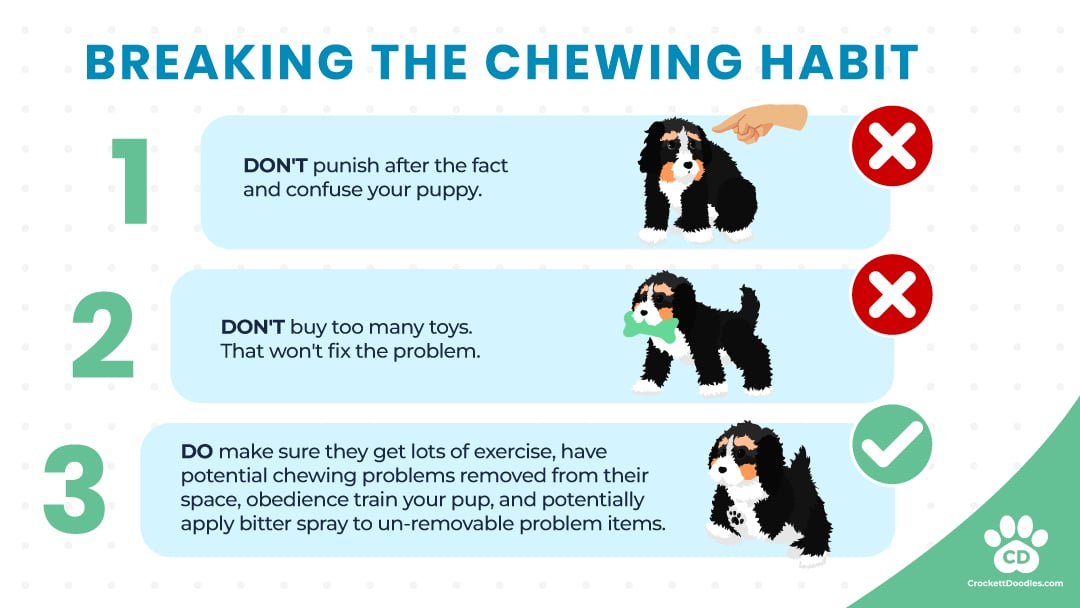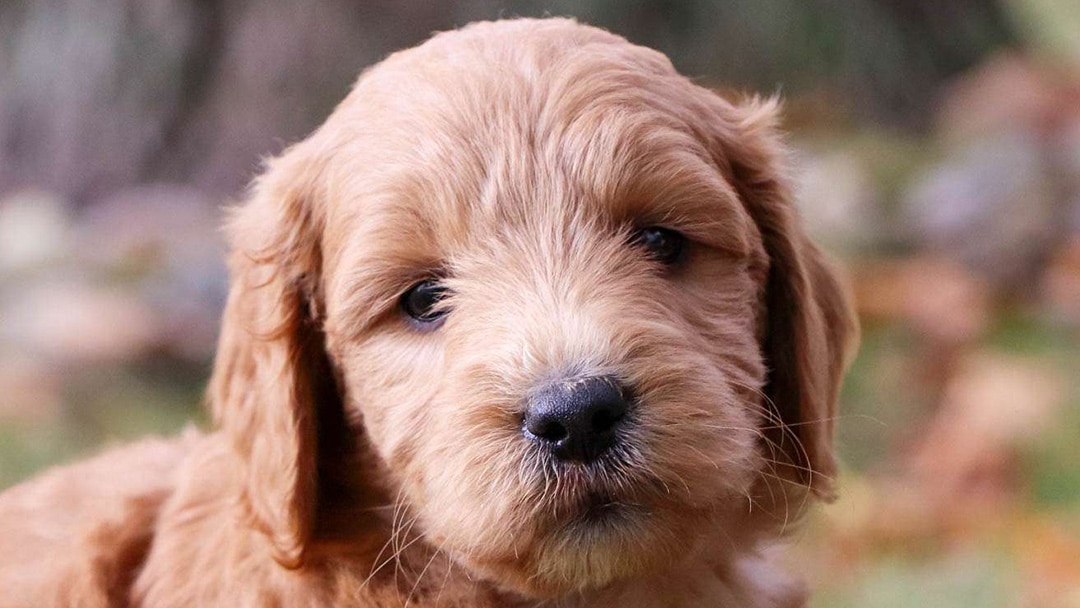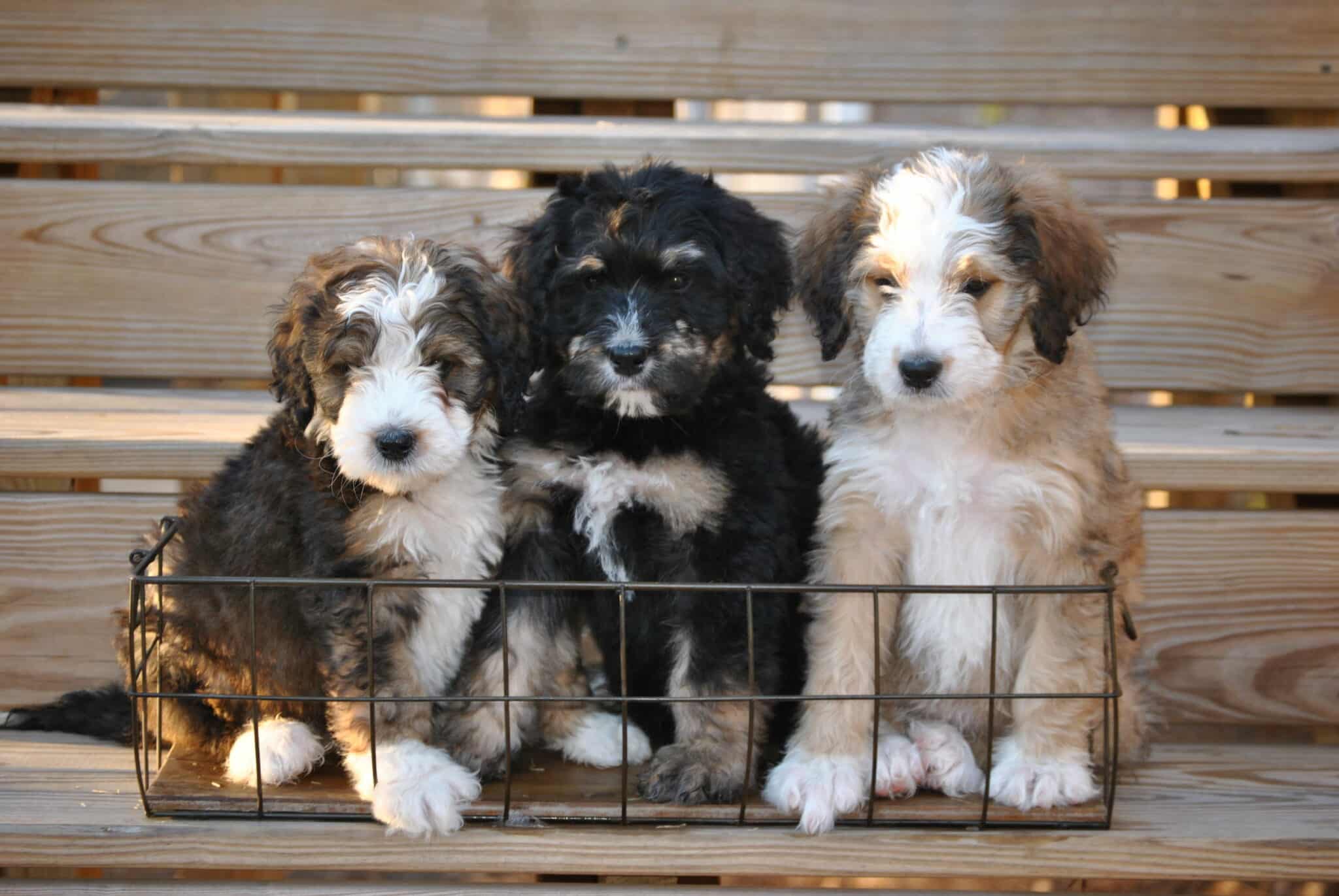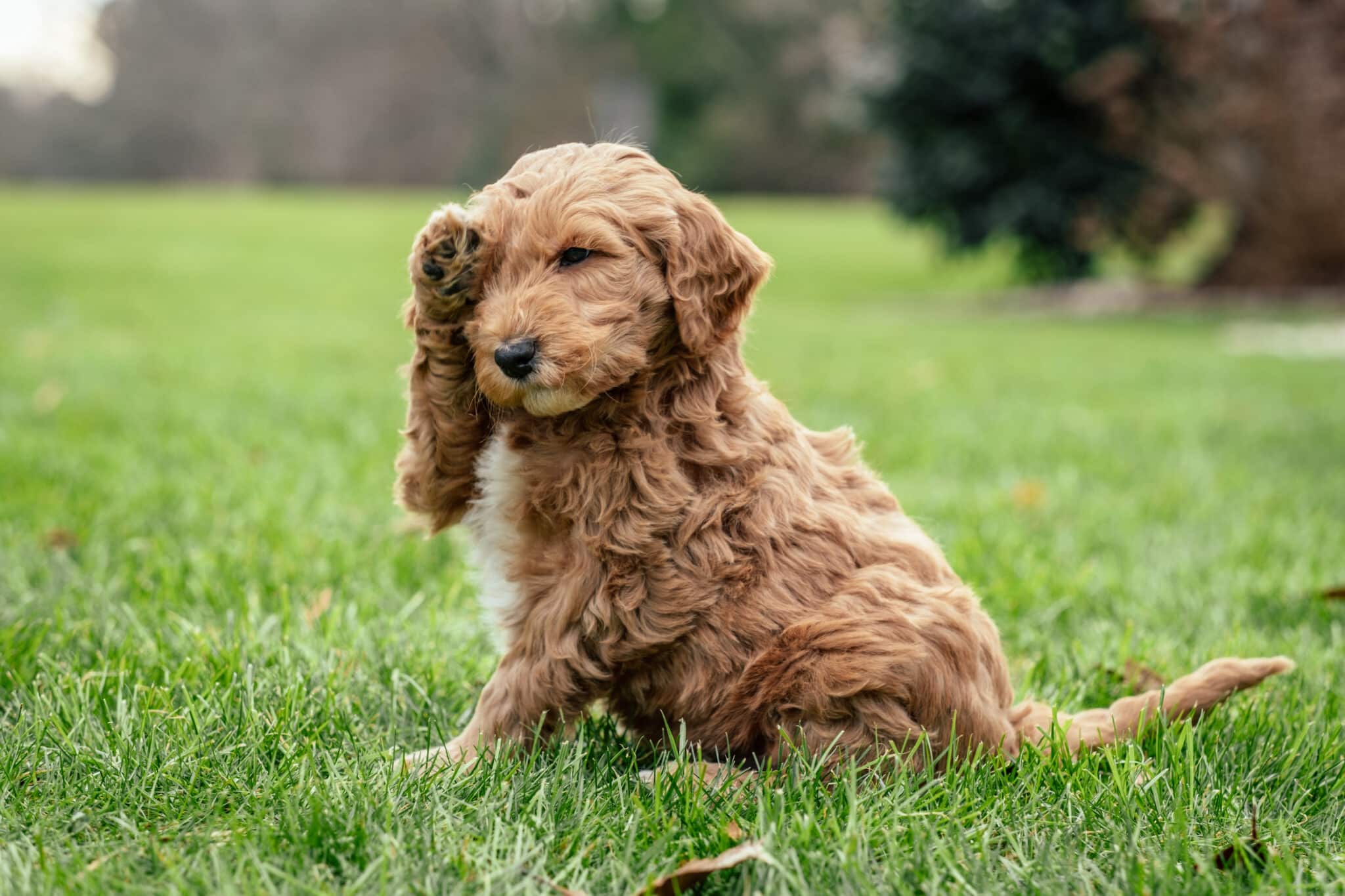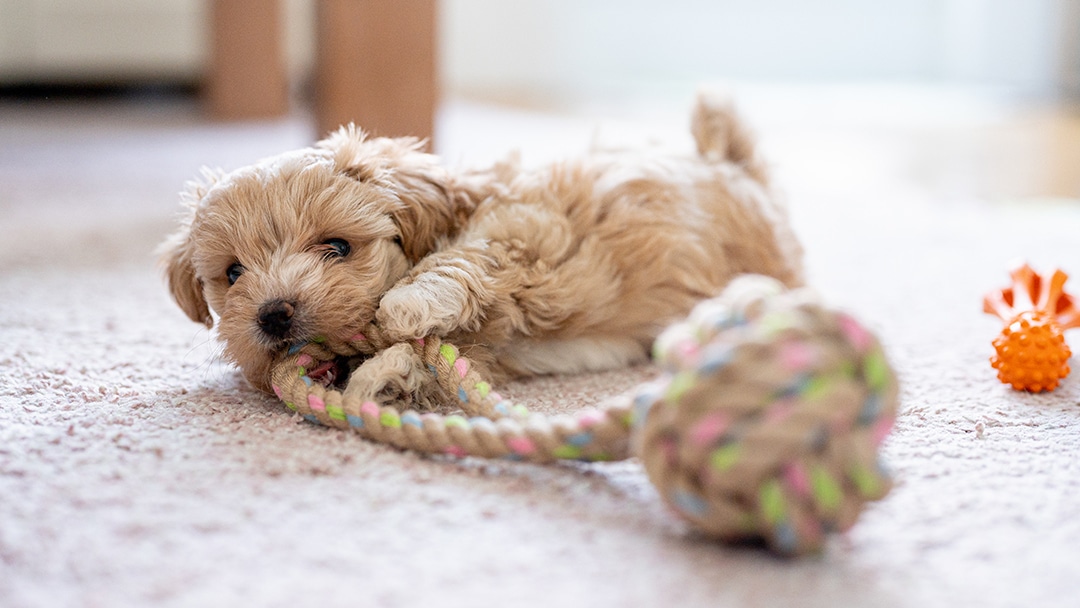Prevent Your Puppy’s Destructive Chewing
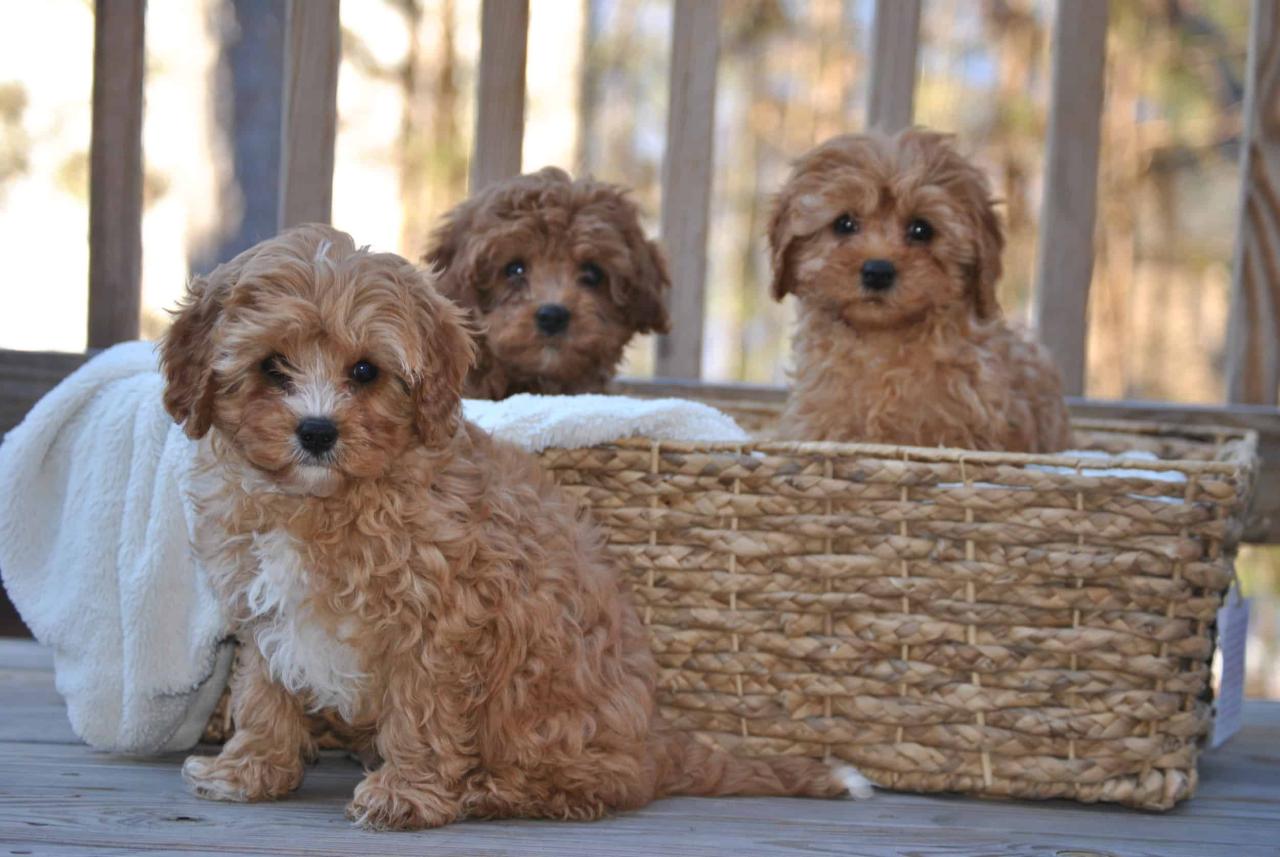
Chewing itself isn’t necessarily a bad behavior. Dogs interact with their environments through their noses and mouths. So the act of chewing is very natural and part of the teething process. However, it can be destructive if your dog is chewing on the wrong thing—like your shoes, furniture, or even you.
The Reasons Behind Your Dogs Chewing
Puppy chewing is a part of your dog’s nature. Between 4 to 6 months of age, your dog’s baby teeth will be gradually replaced with permanent “adult” teeth. During this painful teething period, your puppy may chew more to relieve his irritated gums. If you do not correctly channel your puppy’s chewing habits, it may become a long-term problem.
By identifying why your dog is engaging in the behavior, you’ll find it’s much easier to figure out how to stop it. There are several reasons that your dog may be chewing on that new pair of shoes.
- Puppyhood: Puppies put stuff in their mouths for the same reason babies do—to explore the world around them through taste.
- Teething: Puppies instinctively chew to help their teeth go through the teething process. It also helps relieve tenderness of the teeth and gums.
- Instinct: It is a natural behavior for a dog. Your job is to channel the behavior to an appropriate object—like a toy.
- Boredom: Your dog may just be chewing for fun or to occupy himself to prevent getting bored. It may also be a way to release built-up energy.
- Medical: Although rare, some problems with the diet can lead to pica— the craving of a non-food item.
Mistakes Dog Owners Typically make
There are several mistakes that dog owners make when it comes to bad chewing behavior. Some will punish their dog after the fact; for example, when arriving from work to find something chewed up.
Others will buy excessive amounts of dog toys in the hopes that their dog will simply ignore their surroundings. That might work for a couple days but it won’t take long for the puppy to grow bored again and return to gnawing on chair legs, sofa cushions, and rug fringes.
10 Steps to Preventing your Dog from Chewing
Neither after-the-fact discipline nor truckloads worth of puppy toys are the answer. Instead, I recommend the following multi-prong approach to correcting the puppy’s chewing problem:
- Puppy-proof your home. Instead of constantly reprimanding a young puppy for getting into things, puppy-proof any areas of the house to which your puppy will be given access, in much the same way one would child-proof an area for a baby:
- Temporarily take up any throw rugs.
- Place all plants, poisonous substances, household cleaners, trash receptacles, paper products (such as tissue and toilet paper), shoes, and any small chewable objects out of reach.
- Either remove, cover or tape down all accessible electrical wires.
- Remove or secure heavy objects which could fall or be pulled down and cause injury to the puppy.
- Limit the number of toys. While all puppies should have toys to play with, the problem with providing your puppy with too many toys is that it makes it more difficult for the puppy to differentiate what’s his from what’s yours. Do not provide a destructive puppy with more than a few toys at a time. (This rule does not apply to dogs who are not destructive chewers).
- Safely confine your puppy. Use a suitably sized crate or wire-reinforced puppy gate whenever you’re unable to safely supervise him. When introduced properly and used correctly, crate training is a safe, preventive, effective and humane housetraining tool, which provides the puppy with a secure, protective den, while offering his owner peace of mind. Please note: Introduce your puppy to his new crate using positive association (i.e. feed him in his crate), and never use his crate as a punishment.
- Offer him lots of outdoor exercise. Puppies who are destructive indoors, need one to two hours of active outdoor exercise daily, provided they are fully immunized. Teaching your puppy to retrieve a ball, toy, or Frisbee will help cure his chronic chewing problem. [Note: If your puppy doesn’t have all of his “shots” yet, it is probably NOT safe to allow him to play with other dogs (other than those who are aready part of your household) or to give him any access to outdoor areas where neighborhood dogs go. Final ” puppy shots” are usually administered by a veterinarian when a puppy is around 16 weeks of age.]
- Offer your (fully vaccinated) puppy playtime with a puppy playmate. Lots of active play each day, keeps the hyperactive puppy demons away! A well exercised dog is a well-behaved dog.
- Obedience train your puppy. Just 5 to 15 minutes of training a day can make a big difference. For young, immature and hyperactive puppies who have difficulty concentrating during lengthy obedience lessons, even a few 30-second obedience training “mini-sessions” offered on a daily basis will prove very helpful. Remember to remain upbeat throughout, and always end your sessions on positive note!There are several ways you can learn how to train your dog, including:
- training books and videos
- group obedience classes
- private in-home training
- training seminars and workshop
- Enroll your (vaccinated) puppy in an agility training class. Agility training helps build coordination and confidence, offers your puppy substantial exercise, and is great fun!
- Apply Bitter Apple spray or salve to accessible woodwork and furniture legs. The bitter taste is usually an effective deterrent for most puppies.
- Avoid the futile after-the-fact discipline syndrome. In order to successfully correct your puppy’s misbehavior, you must either catch your puppy in the act, or, better yet, work on preventing his misbehavior to begin with.
- Consider enlisting the help of a reputable dog trainer or canine behavioral consultant if despite these steps, your puppy still acts like a canine demolition crew.
Choose Suitable Chew Toys
Rather than attempting to stifle your puppy’s chewing tendencies, his desire to chew should be constructively channeled and directed towards acceptable items such as his chew toys. Avoid giving your puppy discarded socks, shoes, sneakers or other articles of clothing. While some puppies may learn to differentiate between those things which are his and those which are yours, most puppies cannot.
When it comes to choosing which toys to give your puppy, these are the primary qualities to look for:
- Safety. Only allow him those toys and balls which cannot be chewed apart or accidentally swallowed. Also, beware of bells, buttons and squeakers, which may be hazardous if chewed off of a toy and swallowed.
- Durability. Good chew toys should last a long time.
- Fun. If it’s not, your puppy won’t want to play with it.
- Ease of cleaning. After all, who wants to spend all of their time cleaning chew toys?
I especially recommend the following toys:
- The Tuffy or Kong. These are not only great chew toys, but are also great retrieve toys as well. They have plenty of “give” for puppies who are teething, and are also virtually indestructible for most dogs. In my opinoin, they are two of the best puppy toys on the market.
- Cresite, Beefy Baseball, or other durable rubber balls. Both the solid and hollow thick rubber balls can be rolled across floor for puppy to chase and chew.
- Tennis balls are perfect for teaching medium to large sized puppies to retrieve.
- Starballs. These odd-shaped, erratic-bouncing balls are ideal for the consummate retriever who likes a bit of a challenge.
- Mutt Pucks, which are both hardy enough to last with most puppies, yet are not so hard as to discourage chewing. (Some dogs can chew their toys apart in a surprisingly short period of time. Should this happen with your puppy, remove any pieces which can be swallowed immediately.)
- Buster Cubes and Activity Balls. Fill these toys with kibble or your puppy’s favorite treats and watch the fun begin.
- For special occasions, make “Puppy Cannolis”: hollowed, sterilized beef marrow bones, which can be filled with a thick kibble-based mixture, then frozen.To make the mixture, place I cup dry dog food kibble, 1 small cube of freeze-dried liver, crushed into powder, 1 teaspoon powdered or fresh pressed garlic, and 1 cup warm water. Mix well and let sit for 1 hour. Stuff mixture into beef marrow bone. Cover edges with 1 tablespoon cream cheese or soft Velveeta cheese (optional). Freeze overnight (also optional).Frozen “Puppy Cannolis” should be considered and extra special treat, and offered only on an occasional basis. Make sure the beef marrow bone is big enough that it can’t be swallowed, and that bone fragments are not eaten. Owner supervision is advised.
